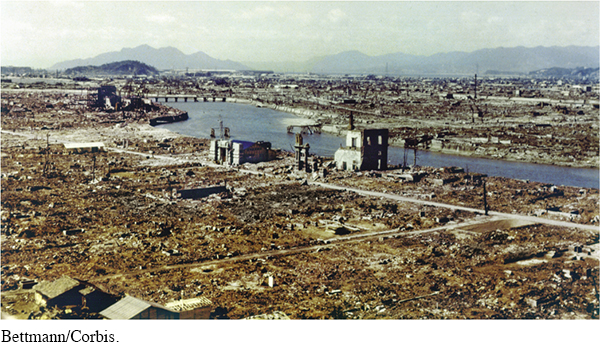Atomic Warfare
In mid-July 1945, as Allied forces prepared for the final assault on Japan, American scientists tested a secret weapon at an isolated desert site near Los Alamos, New Mexico. In 1942, Roosevelt had authorized the top-secret Manhattan Project to find a way to convert nuclear energy into a superbomb before the Germans added such a weapon to their arsenal. More than 100,000 Americans, led by scientists, engineers, and military officers at Los Alamos, worked frantically to win the race for an atomic bomb. Germany surrendered two and a half months before the test on July 16, 1945, when scientists first witnessed an atomic explosion that sent a mushroom cloud of debris eight miles into the atmosphere. After watching the successful test of the bomb, J. Robert Oppenheimer, the head scientist at Los Alamos, remarked soberly, “Lots of boys not grown up yet will owe their life to it.”
President Truman saw no reason not to use the atomic bomb against Japan if doing so would save American lives. Despite numerous defeats, Japan still had more than 6 million reserves at home for a last-ditch defense against the anticipated Allied assault, which U.S. military advisers estimated would kill at least 250,000 Americans. But first Truman issued an ultimatum: Japan must surrender unconditionally or face utter ruin. When the Japanese failed to respond by the deadline, Truman ordered that an atomic bomb be dropped on a Japanese city. The bomb that Colonel Paul Tibbets and his crew released over Hiroshima on August 6 leveled the city and incinerated about 80,000 people, and many thousands more died later from injuries and radiation. Three days later, after the Japanese government still refused to surrender, the second atomic bomb killed nearly as many civilians at Nagasaki. [[LP Photo: P25.11 Hiroshima/

With American assurance that the emperor could retain his throne after the Allies took over, Japan surrendered on August 14. On a troopship departing from Europe for what would have been the final assault on Japan, an American soldier spoke for millions of others when he heard the wonderful news that the killing was over: “We are going to grow to adulthood after all.”
While all Americans welcomed peace, some worried about the consequences of unleashing atomic power. Almost every American believed that the atomic bomb had brought peace in 1945, but nobody knew what it would bring in the future.
> QUICK REVIEW
Why did Truman elect to use the atomic bomb against Japan?
Understanding the American Promise 3ePrinted Page 735
Section Chronology